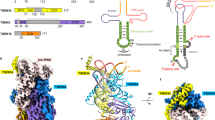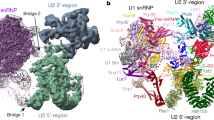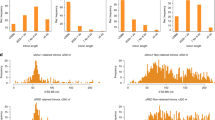Abstract
Similarities between RNA splicing during autocatalytic excision of group II introns and pre-mRNA processing led to the hypothesis that group II introns might be the evolutionary predecessors of spliceosomal small nuclear RNAs1–4. The ID3 subdomain stem-loop structure of group II introns, the proposed analogue of the spliceosomal U5 snRNA5, is thought to be essential for 5′ splice site recognition and anchoring of the free 5′ exon6. Using the group II intron bII we have analysed the role of ID3 in splicing. In the absence of ID3 the 5′ splice site was recognized accurately and efficiently, but exon anchoring was greatly reduced. This step was restored in the presence of RNA fragments consisting of either the terminal stem–loop structure of ID3 or spliceosomal U5 snRNA. This suggests that the predominant role of both RNAs is to anchor the 5′ exon during exon ligation. Furthermore, as U5 complements for the loss of ID3, a similar network of structural RNAs may form the catalytic core of both group II introns and spliceosomes.
This is a preview of subscription content, access via your institution
Access options
Subscribe to this journal
Receive 51 print issues and online access
$199.00 per year
only $3.90 per issue
Buy this article
- Purchase on Springer Link
- Instant access to full article PDF
Prices may be subject to local taxes which are calculated during checkout
Similar content being viewed by others
References
Jacquier, A. Self-splicing group II introns and nucelar pre-messenger RNA introns—how similar are they? Trends Biochem. Sci. 15, 351–354 (1990).
Sharp, P. A. Five easy pieces. Science 42, 663 (1991).
Weiner, A. M. mRNA splicing and autocatalytic introns: distant cousins or the products of chemical determinism? Cell 72, 161–164 (1993).
Wise, J. A. Guides to the heart of the spliceosome. Science 262, 1978–1979 (1993).
Newman, A. J. & Norman, C. U5 snRNA interacts with exon sequences at 5′ and 3′ splice-sites. Cell 68, 743–754 (1992).
Michel, F. & Ferat, J.-L. Structure and activities of group II introns. Annu. Rev. Biochem. 64, 435–461 (1994).
Padgett, R. A., Podar, M., Boulanger, S. C. & Perlman, P. S. The stereochemical course of group II intron self-splicing. Science 266, 1685–1688 (1994).
Moore, M. J. & Sharp, P. A. Evidence for two active sites in the spliceosome provided by stereochemistry of pre-mRNA splicing. Nature 365, 364–368 (1993).
Peebles, C. L., Perlman, P. S., Mecklenburg, K. L., Petrillo, M. L. & Tabor, J. H. A self-splicing RNA excises an intorn lariat. Cell 44, 213–223 (1986).
Schmelzer, C. & Schweyen, R. J. A self-splicing of group II introns in vitro: mapping of the branch point and mutational inhibition of lariat formation. Cell 46, 557–565 (1986).
Van der Veen, R. et al. Excised group II introns in yeast mitochondria are lariats and can be formed by self-splicing in vitro. Cell 44, 225–234 (1986).
Moore, M. J., Query, C. C. & Sharp, P. A. in Teh RNA World (eds Gesteland, R. F. & Atkins, J. F.) 303–358 (Cold Spring Harbor Laboratory Press, NY, 1993).
Jacquier, A. & Michel, F. Multiple exon-binding sites in class II self-splicing introns. Cell 50, 17–29 (1987).
Harris-Kerr, C. L., Zhang, M. & Peebles, C. L. The phylogenatically predicted base-pairing interaction between α and α′ is required for group II splicing in vitro. Proc. Natl Acad. Sci. USA 90, 10658–10662 (1993).
O'Keefe, R. T., Norman, C. & Newman, A. J. The invariant U5 snRNA loop 1 sequence is dispensable for the first catalytic step of pre-mRNA splicing in yeast. Cell 86, 679–689 (1996).
Michel, F., Umesono, K. & Ozeki, H. Comparative and functional anatomy of group II catalytic introns—a rview. Gene 82, 5–30 (1989).
Madhani, H. D. & Guthrie, C. Dynamic RNA–RNA interactions in the spliceosome. Annu. Rev. Genet. 28, 1–26 (1994).
Sontheimer, E. J. & Steitz, J. A. The U5 and U6 small nuclear RNAs as active components of the spliceosome. Science 262, 1989–1996 (1993).
Mueller, M. W., Stocker, P., Hetzer, M. & Schweyen, R. J. The fate of the junction phosphate in alternating forward and reverse splicing reactions of group II intron RNA. J. Mol. Biol. 222, 145–154 (1991).
Mueller, M. W., Hetzer, M. & Schweyen, R. J. Group II intron RNA catalyzes progressive, site-specific, 3′ to 5′ nucleotide insertion: a model for RNA editing? Science 261, 1035–1038 (1993).
Michels, J. W. & Pyle, A. M. Conversion of a group II intron into a multiple-turnover ribozyme that selectively cleaves oligonucleotides: elucidation of reaction mechanism and structure/function relationships. Biochemistry 34, 2965–2977 (1995).
Bachl, J. & Schmelzer, C. Effects of deletions at structural domains of group II intron bI1 on self-splicing introns. J. Mol. Biol. 212, 113–125 (1990).
Suchy, M. & Schmelzer, C. Restoration of the self-splicing activity of a defective group II intron by a small trans-acting RNA. J. Mol. Biol. 222, 179–187 (1991).
Frank, D. N., Roiha, H. & Guthrie, C. Architecture of the U5 small nuclear RNA. Mol. Cell. Biol. 14, 2180–2190 (1994).
Author information
Authors and Affiliations
Rights and permissions
About this article
Cite this article
Hetzer, M., Wurzer, G., Schweyen, R. et al. Trans-activation of group II intron splicing by nuclear U5 snRNA. Nature 386, 417–420 (1997). https://doi.org/10.1038/386417a0
Received:
Accepted:
Issue Date:
DOI: https://doi.org/10.1038/386417a0
This article is cited by
-
Domestication of self-splicing introns during eukaryogenesis: the rise of the complex spliceosomal machinery
Biology Direct (2017)
-
Evolution of group II introns
Mobile DNA (2015)
-
Fixation and Accumulation of Thermotolerant Catalytic Competence of a Pair of Ligase Ribozymes Through Complex Formation and Cross Ligation
Journal of Molecular Evolution (2013)
-
An Overview of the Introns-First Theory
Journal of Molecular Evolution (2009)
-
The rise and falls of introns
Heredity (2006)
Comments
By submitting a comment you agree to abide by our Terms and Community Guidelines. If you find something abusive or that does not comply with our terms or guidelines please flag it as inappropriate.



